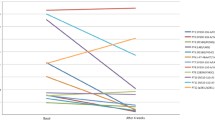Summary
□Patients and Method: 17 patients (8 female, 9 male; age 8.2±3.7 years) with phenylketonuria under phenylalanin restricted diet were investigated prior to and after 3 months of selenium substitution (sodium selenite, 115 µg Se/m2 BSA/d). Different parameters in blood were determined: selenium, glutathione peroxidase (Gpx) activity, thyroid hormones, blood cell count, lymphocytic antigen expression, muscle function and -enzymes, cardiac ultrasound.
□Results: The main significant results of selenium substitution are: increased plasma-selenium, blood cell selenium, plasma-Gpx activity and left ventricular cardiac index as well as decreased plasma thyroxin, free thyroxin, reverse triiodthyronin, total cholesterol, mean erythrocyte and thrombocyte volume and lymphocytic CD2 expression.
□Conclusion: The data indicate metabolic and functional signs of selenium deficiency in patients with phenylketonuria without selenium substitution. We conclude that, despite of lacking clinical symptoms, a selenium supply in phenylketonuria patients under diet is necessary and should be performed with usefull peroral sodium selenite (115 µg Se/m2 BSA/d) initially, followed by a dosage between 30 and 60 µg Se/m2 BSA/d).
Similar content being viewed by others
Literatur
Calomme, M.: Supplementation of phenylcetonuria children with a bacterial selenosource. 30th Annual Meeting of Society for the Study of Inborn Errors of Metabolism (abstract P14), Leuven 1992.
Kauf, E., J. Seidel, H. Dawczinsky, H. Vogel, L. Vogt, D. Schlenvoigt: Selenium deficiency and thyroid hormone status in children. Trace elements in man and animals, Tema 8. Verlag Media Touristik, Gersdorf 1993, S. 170–171.
Lombeck, I., K. Kasparek, H. D. Harbisch, K. Bekker, E. Schumann, W. Schröter, L. E. Feinendegen, H. J. Bremer: II. Selenium content of serum, whole blood hair and the activity of erythrocyte glutathione peroxidase in dietetically treated patients with phenylketonuria and maple-syrupurine disease. Europ. J. Pediat. 128 (1978), 213–223.
Lombeck, I., K. Kasparek, D. Bachmann, L. E. Feinendegen, H. J. Bremer: Selenium requirements in patients with inborn errors of amino acid metabolism and selenium deficiency. Europ. J. Pediat. 138 (1980), 65–68.
Lombeck, I., H. Menzel: Biochemical changes due to a low selenium state. In: Anke, M., D. Meißner, H. Bergmann (Hrsg.): Defizite und Überschüsse an Mengen- und Spurenelementen in der Ernährung. Schubert, Leipzig 1994, S. 95–108.
Oster, O., W. Prellwitz, W. Kasper, T. Meinertz: Congestive cardiomyopathy and the selenium content of serum. Clin. chim. Acta 128 (1983), 125–132.
Oster, O.: Selen — ein essentielles Spurenelement. Med. Welt (Stuttg.) 47 (1996), 12–22.
Paglia, D. E., W. N. Valentine: Studies on the quantitative and qualitative characterisation of erythrocyte, glutathionperoxidase. J. Lab. clin. Med. 70 (1967), 158–168.
Perez, A., J. Néve, J. Duchateáu, V. Siderova, K. Huygen, J. P. Famaey, Y. A. Carpentier: Effect of selenium supplementation on immune parameters in gut failure patients on home parenterale nutrition. Nutrition 7 (1991), 251–221.
Schmidt, K., W. Bayer: Selen. Aktueller wissenschaftlicher Erkenntnisstand. Vitamin Spur 7, Suppl. 1 (1992), 1–23.
Seidel, J., F. Stein, E. Kauf, H. Plaschke, J. Hübscher, L. Vogt, H. Richter, K. Winnefeld, D. Schlenvoigt, K. Bellstedt: Selen-Therapie bei Kindern mit Phenylketonurie (Phenylketonurie) — Untersuchungen zu funktionellen Veränderungen der Herz- und Skelettmuskulatur. In: Anke, M. (Hrsg.): Mengen-und Spurenelemente. Schubert, Leipzig 1995, S. 379–386.
Vinton, N. E., K. A. Dahlstrom, C. T. Strobel, M. E. Amendt: Macrocytosis and pseudoalbinism: manifesttions of selenium deficiency. J. Pediat. 111 (1987), 711–717.
Yagi, K.: Lipid peroxides in biology and medicine. Academic Press, New York 1982.
Author information
Authors and Affiliations
Rights and permissions
About this article
Cite this article
Kauf, E., Seidel, J., Winnefeld, K. et al. Selen bei Phenylketonuriepatienten. Med Klin 92 (Suppl 3), 31–34 (1997). https://doi.org/10.1007/BF03041959
Issue Date:
DOI: https://doi.org/10.1007/BF03041959




